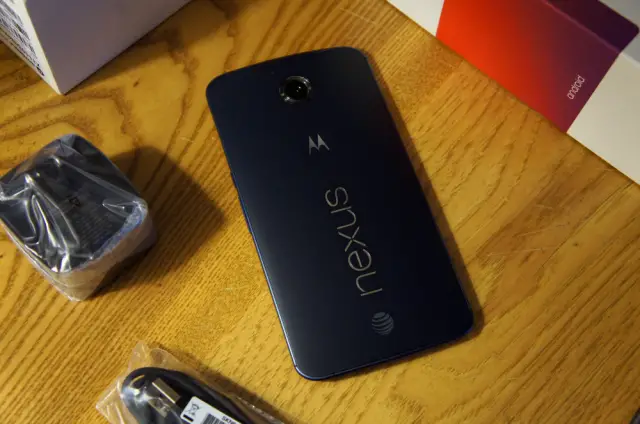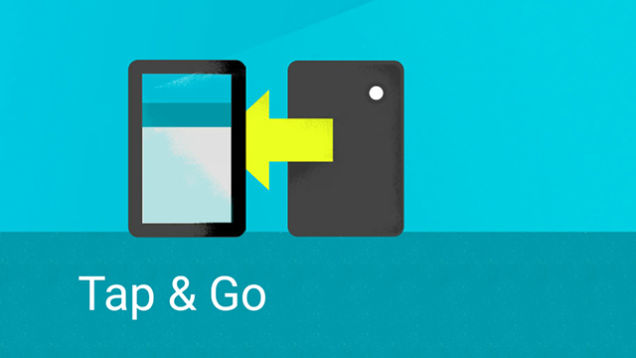
13 Nexus 6 Tips & Tricks

The Nexus 6 (our review) may have been announced a while ago, but that doesn’t mean it’s any easier to buy now. People are still waiting for theirs to arrive, and the Play Store is struggling to keep them in stock. If you’re still waiting, or you finally got one, we have some must-know tips and tricks to help you get the most out of this giant Nexus.
Tap & Go

The first thing you have to do with a Nexus 6 is set it up. Lollipop introduced a new feature called “Tap & Go” which makes the process very easy. If your old device has NFC you can simply tap the devices back-to-back and all your Google account info, settings, data, widgets, wallpapers, and apps will be synced over to the Nexus 6.
Screen Pinning & Guest Mode
A smartphone is full of personal information and sensitive content. This can make it difficult to let people use your phone without your supervision. “Screen Pinning” is a new Lollipop feature that lets you lock your phone to one app.
You can “pin” a specific app so the user can’t do anything else. To enable this feature go to Settings > Security > Screen pinning. Then open the app you would like to pin, press the Overview (formerly multitasking) button, scroll up and tap the blue thumb tack icon in the bottom right corner of the most recent app. To unpin an app simply long-press the back and Overview buttons simultaneously.
Android tablets have had user accounts for a while, but the Nexus 6 is the first phone to get them. By default there is your account and a “Guest Mode.” In Guest Mode users are able to make phone calls and sign into apps as if it was their own device. Your user account is password protected from the guest. To switch to Guest Mode swipe down from the top of the screen with two fingers, tap your profile icon, and choose “Guest.”
Keyboard with Numbers Row
The Nexus 6’s giant display offers a ton of screen real estate, but the default Google Keyboard doesn’t make use of it. With a few tweaks in the settings you can add a number row (and more) to the Google Keyboard.
With the keyboard visible long-press the comma key and select “Google Keyboard Settings” from the pop-up. Next choose “Appearance & Layouts” and then “Custom input styles.” Tap the (+) button in the upper right and choose your preferred language. Now select “PC” from the layout drop-down. Now you just have to back out to the “Languages” options, un-toggle “Use system language” and select the PC layout.
Battery Saver
The Nexus 6 has a big 3220 mAh battery and Turbo Charging technology, but if you still need to squeeze out more juice you can use “Battery Saver.” When Battery Saver is enabled it reduces your device’s performance, turns off vibrations, and blocks most background data. It can be turned on manually or set to automatically kick in when your battery is at 15% or 5%. You’ll know it’s working when the status and nav bars turn orange. Go to Settings > Battery > tap the menu button.
Read More: 15 Tips & Tricks for Android Lollipop Users
Quickly Check Data Usage
Here’s a quick way to check how much data you’ve used. Simply tap on the data connection from Quick Settings and you can see how much data you’ve used in the last month. It also shows any warnings or limits you have set up, and tapping “More settings” takes you to the full Data Usage page in the Android Settings.
Set your account photo
You’ll notice that the Nexus 6 (and Lollipop in general) shows a tiny profile icon in the upper right of the lock screen and notification shade. By default it shows a generic silhouette, but you can change it to something more personal.
To do this swipe down from the top of the screen with two fingers. Tap on the little profile icon and you’ll see the users on your device. With your account selected tap “More Settings.” On the next screen tap on you account and a pop-up will allow you to change your name and photo. We’re not sure why it doesn’t automatically use your Google account photo, but at least it’s easy to fix.
Control Notifications
The Nexus 6 and Lollipop give users control over notifications like never before. Every app installed on your device can be configured to send notifications only when you want to see them. You can also put the phone is special modes to restrict notifications. Each app can be put into three notification categories:
Block – Never show notifications from the app.
Priority – Show notifications at the top of the list and let them through when in Priority Mode.
Sensitive – Content is not displayed in the lock screen notification
To adjust the notification options for apps go to Settings > Sound & notification > App notifications. To switch your phone into Priority Mode or Do Not Disturb Mode press the volume keys and use the options in the pop-up.
Smart Lock
It’s a good idea to have a layer of security on your device. The only problem with using a password or pattern lock is that it ends up slowing you down way more than anyone else. The Nexus 6 has a feature called “Smart Lock” that lets you tell your phone when it’s safe. Right now there are three ways to make your phone trust you.
Trusted devices – Any Bluetooth or NFC device can be added here. When those devices are connected your lock screen security is disabled.
Trusted face – This is Google’s much better implementation of “Face Unlock.” After you scan your face it will look for you every time you unlock your device. If it recognizes you the lock screen security will be disabled.
Trusted places – In this option you’ll see any locations you’ve added to your Google account. You can toggle those on or add a new place manually. When you are in those locations the lock screen security will be disabled.
With these three options you can make it so you don’t have to constantly enter passwords or patterns, but if your device is stolen or left behind it will know to lock others out. These options can be accessed in Settings > Security > Smart Lock.
Read More: Top 10 Android Lollipop Features [VIDEO]
Lock Screen Shortcuts
The lock screen has a few shortcuts that can get you into certain apps quickly. Swiping up on the lock screen unlocks the device, but swiping right launches the camera (or apps like Snapchat), and swiping left goes straight to the phone. These are two things you don’t want to be fumbling around to find.
Shoot 4K Video
Did you know you are now the proud owner of a 4K camera? Google hasn’t advertised it a lot, but the Nexus 6 can indeed shoot 4K video. To enable 4K video open the default Google Camera app and swipe from the left side to open the menu. Tap the settings icon in the lower right of the view finder. On the next page tap “Resolution & quality.” Here you can adjust a few things, but we’re interested in “Back camera video.” Switch that to “UHD 4K.” Now go shoot in 4K!
Enable High Quality Audio
If you watch a lot of stuff with the Google Play Movies & TV app there is perhaps no better device to own than the Nexus 6. It has a huge beautiful display and awesome dual front-facing speakers. There is even a way to turn on surround sound audio.
In the Play Movies & TV app swipe from the left and select “Settings.” Scroll down and make sure “Enable surround sound” is checked. You can then play a demo to listen to the surround sound in action. It sounds great with the speakers, but if you have headphones available you’re in for a real treat.
“Ok Google” When Device is Locked
The Nexus 6 is one of few devices that can hear the “Ok Google” command while locked. With this feature you can ask “how many ounces in a pound” without touching your phone with dirty hands, or start playing music from across the room.
Swipe up from the Home button to open Google Now. Swipe from the left and tap “Settings.” Tap on “Voice” and then “Ok Google’ Detection.” Before you can turn on “Always on” and “When locked” you’ll need to train the voice model. It will ask you to say “Ok Google” three times and then you can toggle the switches.
Turn Off “Merged Tabs”
Chrome on the Nexus 6 comes with a feature that merges tabs and apps in Overview (formerly multitasking). Instead of seeing your tabs in Chrome they get put into the same place as recent apps. This feature sounds like a good idea in theory, but in practice it’s annoying.
The problem is you end up with a million tabs open and no easy way to manage them. Overview remembers dozens and dozens of recent apps, so if you opened a tab once and never looked at it again it’s lost way back in the list. To turn of merged tabs go into the Chrome settings and change “Merge tabs and apps” off.
Even More Tips & Tricks
This list is just the tip of the iceberg for what you can do with the Nexus 6. We’ve got a bunch more guides and how-to’s in the Nexus 6 forum. Here are a few to get your started.
- How to access files
- How to unlock bootloader
- How to change keyboard
- How to block a number
- How to create folders
- How to add widgets to home screen
- How to use Wireless Charging
- How to factory reset
- How to Turbo Charge
- How to take a screenshot
***
The Nexus 6 is a big phone with big features. If you don’t know what to look for you can miss a lot of the best things. Hopefully this list shed some light on features you didn’t know about. What is your favorite thing about the Nexus 6? Did you know about these tips and tricks?
